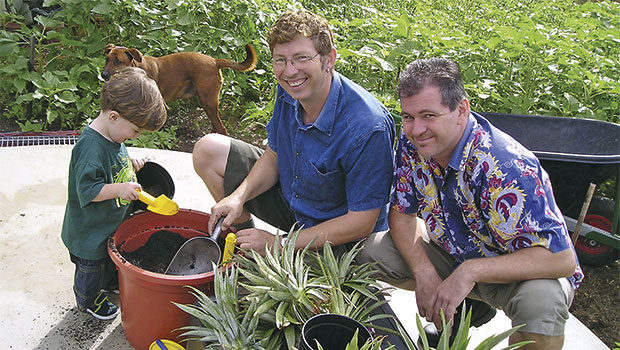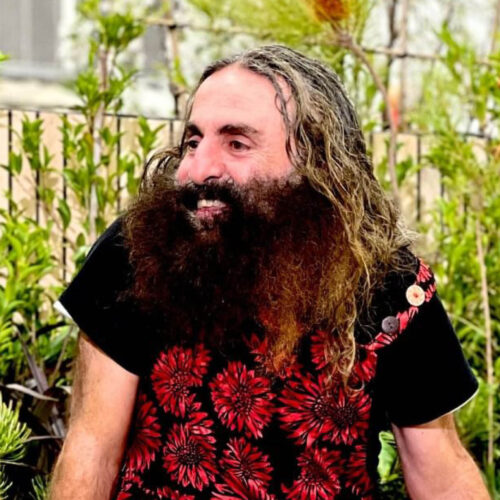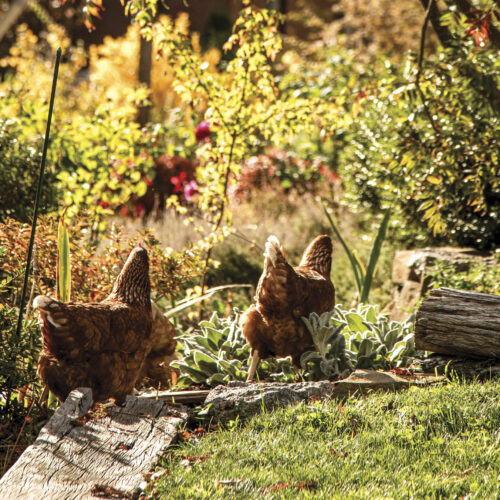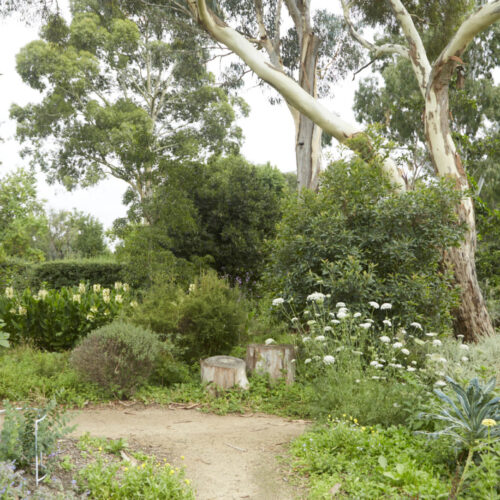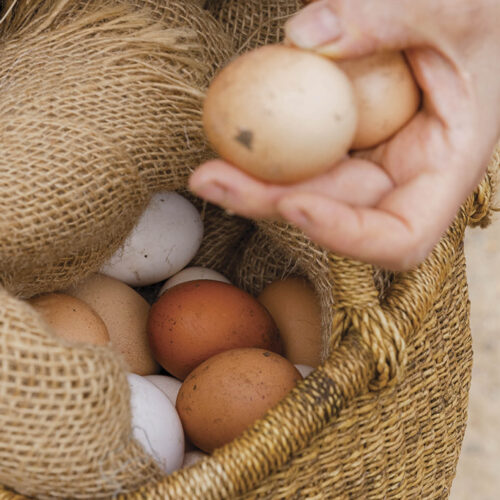The sustainable block
2013-04-27T11:34:17+10:00
After 11 years in Sydney, Jerry Coleby-Williams and Jeff Poole decided to realise their passions for gardening and living sustainably.
We all want to live well and enjoy life, but the growing realisation that domestic living in the “overdeveloped” world wastes finite resources, increases pollution and worsens global warming makes the “enjoying” part that much harder. The good news is that environmentally aware designers and engineers have for some time been creating products and systems (available to most households in Australia) that reduce our impact on the natural world.
In England during the oil shocks of the 1970s, there was insufficient energy to run industry, commerce and transport, and to heat, cool or light Britain’s homes for more that a few hours each day. The government, finally panicked into action, introduced fuel rationing, rostered power cuts and a three-day working week. Inflation and unemployment rose, the economy crashed and Britain was temporarily forced to take sustainable living seriously.
For most Australians the British experience of an oil-dependent economy without enough oil is unthinkable. World oil production has peaked and prices are not going anywhere but up, yet demand for fossil fuels keeps growing. It’s just one of humanity’s pressing issues. The problems of global warming, food security, sustainable energy, population and resource use will not go away. We will become a conserver society soon enough. The question we need to ask is how will we make the change? In an ordered way by choice, or chaotically when there is no choice left?
Big issues don’t always require big answers. Part of our dilemma lies in the problems brought by the big solutions themselves.
Desalination increases the amount of potable water but fails to address the underlying problem: polluting oceans and atmosphere to use drinking quality water once only and for any purpose. Why not recycle city wastewater? More dams with higher walls work when there’s certainty rain will continue to fall in metropolitan catchments as they did before rainfall patterns started altering. As Adelaide, Brisbane, Melbourne, Perth and Sydney have discovered, we can’t claim that certainty any more.
Our cities could be our greatest ecological assets. On our most fertile, most reliably watered soils, Australians have the advantage of living in spacious garden cities. So why aren’t we using this resource to grow food and harvest water and energy? Of course we’ll have to stop overburdening our cities with yet more people, but that lesson may take a little longer to learn.
Our history and the current global scenario is part of our motivation for creating Bellis. Another inspiration was Michael Mobbs, the Sydney lawyer who became famous for his inner-city terrace renovation that created a home almost entirely self-sufficient in electricity, water and waste disposal (documented in his book Sustainable House). Mobbs’s home was a powerful demonstration of how one individual can drive change.
Finding a property
Becoming the proud owners of a 1914 Queenslander house, we began to look at the possibilities. Developers and architects don’t usually think twice about knocking over a sound, existing home to build another. We felt it very important to reuse, and as we are “old stuff” junkies, the place fitted perfectly with our slightly battered Edwardian furniture.
Queenslander houses are already relatively energy efficient. This one has a large under-house space, breezeways and numerous windows to allow good ventilation throughout. Apart from the very hottest, stickiest days of Brisbane’s most recent record-breaking summer, natural ventilation makes indoor living comfortable without energy-consuming air-conditioning. Nevertheless, we installed a six-panel solar power system that feeds surplus power to the grid during the day, and draws down at night.
The under-house space was ideal for installing the planned sewage digesting system, saving valuable garden area while providing convenient access for plumbing and electrical work.
Once we had found the property, Michael Mobbs (who worked with us as a consultant) began liaising with Brisbane City Council, arranging site inspections and diagrams for the sewage system. The council and its officers are keen to encourage domestic water savings to reduce pollution in Moreton Bay and cut peak stormwater flows. All the systems we have used are off-the-shelf goods that can be fitted by local tradespeople and are easily maintained. Michael showed that you don’t need to be skilled, wealthy or live on an acreage to begin to live sustainably.
Rainwater harvesting
South-East Queensland is one of the most rapidly growing population centres in the country and the region has been suffering drought for years.
On arrival in November 2003 I worked out a water budget, based on the 50-year average rainfall recorded at Brisbane Airport, close to where we live. I estimated a 21,000-litre rainwater tank would supply all house and garden needs for two people for about one month. But three people live here now and when, in 2006, the tank ran out for the second spring in a row, I decided to permanently garden in drought mode. This has meant adapting to using 350 litres of recycled black water a day for gardening, and only using rainwater when essential.
When the tank was poured on-site into a pit, excavation generated 37 cubic metres of subsoil. Normally this mostly heavy clay would have been sent to landfill, however we are aware of the problems of rapidly filling landfill sites so we decided to deal with it on site. Some was used for backfilling around the finished tank; the rest was levelled, conditioned and is growing its third green manure crop.
Three leaf- and mosquito-excluding rain heads have been fitted, one atop each downpipe, to prevent any debris dropped by the neighbouring Callitris trees from entering the tank. The base of each downpipe is fitted with a first-flush device that collects the first flush of rainwater from the roof in every shower of rain, removing any animal droppings, dust or other contaminants washed off the roof. The rainwater tank is then gravity filled.
A pump supplies the house on demand – turn on a tap and the pump is activated, supplying taps, washing machine, shower and a drinking fountain that uses a porcelain sediment filter and an activated carbon filter. We have been filtering all tap water for drinking since the Sydney water crisis of 1998.
The rainwater tank overflows about twice each summer, and this overflow is directed into agricultural drainage pipe, laid in gravel-lined trenches 70cm deep. This pipe system deeply waters the front and back gardens, and when this has saturated the soil, the pipe discharges the surplus into a stormwater soakaway pit in the front garden. Growing native swamp plants, this pit deeply waters the ornamental subtropical front garden which otherwise depends on natural rainfall.
Digesting the sewage
All waste water from the house goes into a treatment system that, unlike a more conventional grey water system, also digests all solid waste, passing solids back and forth between an anaerobic and aerobic tank. Water from the system is passed through a sand and gravel filter to a holding tank and then through an ultraviolet filter for final chemical-free disinfection. By this stage the water smells simply of water and gravel, and is ready to flush the toilet or water the food garden.
The sewage digesting system is Australian-made and consists of four holding tanks: two 3000-litre tanks, one 2500-litre tank and one 800-litre holding tank. Usually these are buried below ground, but installed under a Queenslander we needed only to bury them by a quarter of their height, saving excavator time and cost, and reducing the amount of excavated soil to reuse in the garden.
Independent water quality testing over the first 18 months showed no viral, bacterial or any other contaminants in the recycled water. The system outperformed our expectations. Using state government figures, our sewage system produced water of a quality equal to that of the best grey water treatment system.
Designing the garden
The original garden was a blank canvas: a double block of 810 square metres of semi-desert: compacted soil covered by a threadbare, weedy lawn with a 150-square-metre house in the middle.
I wrote a design brief because getting ideas into a coherent document is a very important part of the creative process. It not only guides the physical design but also compels you to make sense of what you want to achieve.
That done, I was able to quickly draft a plan for the organic garden – pretty at the front and productive at the back. Nick Walford-Smith, a landscape designer on the Gold Coast, worked with me to improve the design.
Start with the soil
It’s likely that prior to clearing, the land where we now garden would have supported Melaleuca leucadendron and Eucalyptus tereticornis woodland. Soil conditioning was based on thorough laboratory testing to confirm the general soil type, pH, soluble salts (such as sodium chloride), organic content, particle size, macronutrients (nitrogen, potassium and phosphorous), micronutrients (such as magnesium and iron) and for the presence of heavy metals (such as lead and cadmium). Four samples were taken from the topsoil and subsoil. Photographs and a description of the soil profile were provided.
The soil tests showed we had bought a plot of ancient acid sulphate soil that had become a slightly macronutrient poor, heavily leached, sandy silt over a deep, cracking clay.
In the first summer it had a bad habit of changing from a water-repellent dust bowl to a gluey rice paddy in just two showers of rain. It was starved of organic matter, and it took almost a year of soil improvement before it became hospitable enough to find the first earthworm. It took two years of soil conditioning with dolomite to raise the pH from its original reading of 5.3 (acid) to 7 (neutral).
Insects welcomed the cover crop and green manures sowed to improve the soil. Dragonflies, mantis, assassin bugs and several different predatory and parasitic wasps were quick to take up residence. From then on I was no longer gardening on my own; I had acquired allies. They helped control the various caterpillars and grasshoppers that proliferated with the growth of my soil-improving plants.
A new organic food garden
Everything is cultivated organically, including a model sustainable lawn, and ornamental and productive plantings are a mixture of Australian and exotic plants that enjoy the local growing conditions.
Features for the front garden include plants endangered in the wild: a winter flowering hedge of Phillip Island hibiscus (Hibiscus insularis), a Chilean wine palm (Jubaea chilensis), bottle palm (Hyophorbe lagenicaulis) and spindle palm (H. verschaffeltii). All of these have been propagated from mother stock in cultivation.
In the perimeter borders of the back garden grow shade-giving clumping bamboos (Bambusa oldhamii and Thyrsostachys siamensis), as well as pineapple, avocado, lemons and limes. Native fruits include Australian plum (Planchonella australis), Australian finger lime (Citrus australasica) and Australian round lime (C. australis).
Eight raised beds form the core of the food garden. These are dedicated to seasonal crops, which are grown on a rotational basis.
Diverse vegetables, fruits, herbs and spices, generally numbering between 75 and 120 cultivars, are grown to make full use of the garden space and available water to guarantee a reliable food supply for three people, whatever the weather.
An electric lawnmower and a rechargeable battery-operated lawn edger keep a small organic lawn in good condition, and there’s an old-fashioned hand-propelled mower for backup.
Benefits and savings
Moving from a cooler and wetter Sydney to a warmer and drier Brisbane made it hard to forecast water savings, so we kept daily rainfall records with weather notes and learned as we went. We’ve found that three-minute showers are necessary to eke out a full 21,000-litre rainwater tank over eight weeks of drought. These dry periods are twice as long as we expected, and an extra 10,000-litre tank would be a wise investment.
Surprisingly, over the past five years of drought, Bellis has been about 98 per cent self-sufficient in water. That involved harvesting about seven megalitres of rain (falling rain and harvested stormwater), while the sewage system has recycled about three megalitres of waste water. In other words, Bellis has prevented 10 megalitres of waste water and stormwater from entering Moreton Bay, reducing the pressure to build new dams and desalination plants in Queensland.
The mature organic food garden, hand-watered with 350 litres of recycled waste water a day, supplies 70 per cent of the fresh fruit, vegetables, herbs and spices the three of us need, so our food shopping bills are pretty low. In August I found that the garden could also feed 100 people over a weekend – and still have a large surplus afterwards. The most reassuring thing is that Bellis demonstrates that an average sized back garden can feed a family whatever the weather.
Since founding Bellis, colony collapse disorder of honeybees has emerged to threaten food security. I’m grateful to Damien, the third denizen, for reminding me that sustainability is a lesson we are learning. He persuaded me to use the top of the rainwater tank for an apiary instead of building a gazebo there.
We have had the time, opportunity and ready cash to retrofit Bellis, doing several things at once, but the systems we’re using can be installed separately. The trick is to follow Michael Mobbs’s advice: “Take small, affordable and manageable steps that you can guarantee to carry out.” Sustainability is, after all, the art of living within limits.

